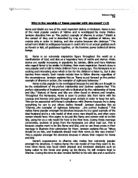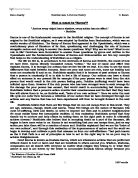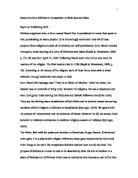"It is essential for Hinduism to reform but the most important issue was the nature of the reformation" Discuss this claim with reference to the activities and teachings of A) Ramakrishna and B) Daynanda Sarasvati.
"It is essential for Hinduism to reform but the most important issue was the nature of the reformation" Discuss this claim with reference to the activities and teachings of A) Ramakrishna and B) Daynanda Sarasvati At a time where India was facing social, economical and political reform it was absolutely vital that Hindu religion and culture developed in a way that would not only preserve Hinduism but also withstand foreign religious and social criticism. Reform at this stage was inevitable but more important was the nature of this reform. The key aim was to enhance and preserve the development of Hinduism and so different people reacted to this in different ways depending on their faith and key ideas. Ramakrishna focused on spiritual development and allowed a liberal view of God. One main theme that was reinforced by Ramakrishna was his desire to "see in God in all". Ramakrishna believed that true self-realisation only came when everything was transformed into a manifestation of God. "I have now come to a stage of realization in which I see that God is walking in every human form and manifesting Himself alike through the sage and the sinner. God in the form of the saint, God in the form of the sinner, God in the form of the righteous, God in the form of the unrighteous." For Ramakrishna all the religion led to the same destination. This has become one of the modern
b) Why is the worship of Rama popular with devotees? (12)
Why is the worship of Rama popular with devotees? (12) Rama and Shakti are two of the most important deities in Hinduism. Rama is one of the most popular avatars of Vishnu and is worshipped by many Hindus. Jamison describes him as "the perfect example of dharma in action." Shakti is the consort of Siva, and is described by Ling as "the goddess of Nature, she creates only in order to destroy, and she creates because she destroys." The actual term Shakti is ambiguous because it could refer to an actual goddess such as Parvati or Kali, all goddesses together, or the feminine power behind all divine beings. b) Rama is an extremely inspiration figure throughout the world as a manifestation of God, and also as a legendary hero of myths and stories. Hindu stories are rapidly increasing in popularity by Jainists, Sikhs and Hare Krishnas who regard Rama to be similar to Krishna, their main inspiration. Rama's story is very popular and is told to Hindu children from a young age. The Ramayana is an exciting and interesting story which is fun for the children to listen to, but it also teaches them morals. Such morals include how to follow dharma regardless of the circumstances. Jamison explains this as "Rama is put forward as the perfect example of dharma in action, the exemplar of righteous behaviour." Rama is also popular to be worshipped because he and Sita are thought to be the
Introduction to Hinduism.
Hinduism is the name given to a family of religions and cultures that began and still flourish in India. Like other Eastern religions, it doesn't fit comfortably into the same box as Western religions like Christianity. Hindus do not separate religion from other aspects of life. For Hindus in India, Hinduism is an inextricable part of their existence, a complete approach to life that involves social class, earning a living, family, politics, diet, etc., in addition to the things Westerners view as religious. The word "Hindu" comes from the name of the river Indus, which flows 1800 miles from Tibet through Kashmir and Pakistan to the sea. Originally the name referred to people living in a particular region of the world, regardless of their faith; so in the 18th century someone could quite sensibly be described as a "Hindu Muslim". There are 750 million Hindus in the world, and most of them live in India. In the UK there are 400,000 Hindus, 160,000 of whom are active in their faith. Hinduism includes a very wide range of beliefs and practices, so there aren't many things that are common to all Hindu groups. However they all have a "family resemblance" to each other. Hinduism has no founder, no creed, and no single source of authority. The things most often common to Hindus are a belief in a single Divinity or supreme God that is present in everything, belief in
How is Hinduism different from the other two major world religions?
Hinduism is different from the other two major world religions (Christianity and Islam) in that there is no single omnipotent paternal deity that governs people's actions. Hinduism is pantheistic, that is, it states that there is one super being and it is present in all material things and living beings. Hinduism does not have a single founder, a specific theological system, a single system of morality, or religious organization. There are many manifestations of the Creator, the Brahman, which take the form of many gods and goddesses. The Hindu believe that because all reality is a unity, worshipping different gods will in the end connect them to Brahman, because he is one. Out of this principle of unity stems the concept of accountability of one's actions in this earthly life. The rise in popularity of Hinduism in the last half of the last century is attributed to this very principle, because it can be compared with the Earth's ecosystem of interdependencies of different biological levels of organisms. The followers of Hinduism are motivated to behave according their religion's moral code not because of the fear of successive punishment. Rather, they know that everything in this world functions according to the cause-and-effect principle and one's actions today will lead to the inevitable consequences after the incarnation. The notions of Karma, reincarnation, and Varna work
Problems that sikhs face practicing their religion in Britain today
Discuss the difficulties members of the Sikh faith have practicing their religion in Britain today. Sikhism was born in the Punjab area of Asia which falls into present day states as India and Pakistan the main religions of that time were Hinduism and Islam. The Sikh faith began around 500 years ago (1500 CE) when Guru Nanak started preaching a faith that was quite distinct from Hinduism and Islam. Nine gurus followed Guru Nanak and developed faith over the next centuries. Sikhism is the youngest of the six world faiths and is the second smallest of all. Sikhism was formed from Hinduism and Islam. Sikhs follow the teachings of the 10 Gurus, The Gurus (meaning religious leader) are not worshipped. Their teachings are recorded in the Guru Granth Sahib, the Sikh holy book. The 2001 census recorded 336,000 Sikhs living in Britain. Britain is becoming more and more multicultural and there are more Sikhs now than ever before. As Britain is predominantly Christian, many Sikhs face difficulties in practising their faith. Like some other religions, Sikhs are often discriminated against in Britain today. The war on Iraq brings with it an increase in hostility towards those who wear turbans making it hard for some Sikhs to show pride in their religious clothing. The turban has become an important symbol of the Sikh faith. Most Sikh men wear a turban as well as some Sikh women. Sikhs
To What Extent Was Mohammad Ali Jinnah Responsible for The Foundation of Pakistan?
To What Extent Was Mohammad Ali Jinnah Responsible for The Foundation of Pakistan? Pakistan was formed out of the northwest provinces of India which contained a majority of Muslim inhabitants and so became an independent Muslim state from Hindu India. Muslims had found it increasingly difficult to become apart of India with the dominant Hindu community discriminating against them, and so a state like Pakistan was sought for the interests of the Muslim Community. However, an ongoing question amongst historian considers who was responsible for the foundation of Pakistan and in particular, how responsible was the 'Qaid e azam.' Mohammad Ali Jinnah played a large role within Muslim politics, initially apart of The National India Congress and elected to the Imperial Legislative council. However, perhaps most importantly, Jinnah became the President of the All India Muslim League after being a significant member for many years. Furthermore, Jinnah attended Round Table conferences in England causing great influence within the British government. Many suggest that Jinnah was the leader of the Pakistan movement spurring the Muslim community forward in search of equality and freedom and in essence creating such a movement and evidently the gain of a separate Muslim state. Perhaps as a show of appreciation, Jinnah was elected as the first President of Pakistan and is still
What is meant by "Karma"?
What is meant by "Karma"? "Just as every object has a shadow, every action has an effect." - Buddha Karma is one of the fundamental concepts in the Buddhist religion. The concept of Karma is not original to the Buddhist religion, as it was adopted by Buddha from Brahminism, which was an earlier version of Hinduism. The theory of Karma first appeared in the Upanishads, which was a revolutionary piece of literature of its time, questioning and challenging the role of humans alongside nature and trying to answer the classic questions: Why? Why are we here? What is our role in life? Doctrines were formulated to answer these questions by gurus and written in the Upanishads and the fundamental doctrines of Karma and Reincarnation are two key concepts that helps in the understanding of Buddhism as a religion. The life we live is, in accordance to the doctrines of Karma and Rebirth, the result of how we have lived. Karma literally translated means "Action." The law of cause and effect best explains Karma. It is through our actions that we live the life we lead. It is clear to see the stark differences that exist between humans. Some are poor and some are rich, some are healthy and some are constantly ill and so on. Buddhists explain that it is because of past actions or Karma that a person is constantly ill or is able to live a life of luxury. Our actions can have a direct effect
Describe Hindu belief in respect for all living creatures In Hinduism, one of the fundamental beliefs is that all
(a)(i) Describe Hindu belief in respect for all living creatures In Hinduism, one of the fundamental beliefs is that all living creatures should be respected. This belief comes from various principle and teachings within Hinduism. Brahman is a very important concept in Hinduism and originates from the earliest scriptures. Priests of the early Indian culture called the magical power of nature 'Brahman' in their rituals with the 'brh' root meaning 'giving forth' or 'growth and creation'. Later on Brahman became known as the life-giving power of the universe. This power dwell in every corner of the universe and beyond as it is a mysterious concept to grasp and many writers of Hindu scriptures used poetry to try and describe Brahman. Many religions accept the existence of a soul or spirit embodied in everyone, containing their divine nature or God being present within them. For Hindus the person does no only consist of body and soul but a true, eternal, perfect self within a temporary and imperfect body. This inner self is known as the atman in Hinduism and as the body dies, the atman, the eternal, indestructible essence of the living being leaves the body to go to another body. This is known as reincarnation. So if every thing in the universe, including living creatures, contains an atman that has the essence of Brahman, Hindus should respect it. There are two stories that
Religious beliefs.
Religious beliefs. The religions of Judaism, Hinduism, and Buddhism all have there own beliefs. These beliefs play a big role in a person's everyday life, and influence aspects of their culture such as holidays, diet, social structure, art, and music. In Judaism, they believe that the Sabbath day should be kept holy, and that you should follow the Ten Commandments, the laws of G-d. Their diets consist of kosher food, and have there own New Year, Rosh Hashanah. Hindus believe in Brahman and Karma, which are both a part of the cycle of birth, death, and rebirth. They're vegetarians, and have a fairly complex social structure called the caste system. Buddhists believe in Buddha's teachings of the Four Noble Truths. These lead to there belief in following the Eightfold Path in order to reach nirvana. Their art consists of statues of the Buddha, each part having its own meaning. Their music was for the temple and they had their own special way of singing. Two basic beliefs in the religion of Judaism are that the Sabbath is holy, and that you should follow the Ten Commandments. Sabbath, or Shabbat in Hebrew means "cease" or "desist." It takes place from sunset on Friday until sunset on Saturday, and you are prohibited from doing any work, unless it severely effects your life or health. The mistress of the house lights two white candles and says a blessing. An Omeg is held after
Ideas Central to Sikhism in Comparison to Hinduism and Islam
Ideas Central to Sikhism in Comparison to Hinduism and Islam Reyte on Publishing 2010 Sikhism originated when a Guru named Nanek Dev Ji proclaimed he heard God speak to him, proclaiming he was a prophet. (It is interestingly convenient how all of these prophets from religions outside of Christianity are self-proclaimed). Guru Nanek traveled throughout India teaching of a unity of Hinduism and Islam (Hopfe & Woodward, 2009, p. 75). He was born April 15, 1469. Following Nanek were nine Gurus who were the teachers of the religion. The final teacher died in 1708 (Hopfe & Woodward, 2009, p. 76). According to the history of the religion, each of these Gurus were able to attain salvation through meditation and prayer to God. Guru Nanek first message was "There is no Hindu or Muslim." After his vision, the mission was to reconcile or bring unity between the religions. He was a missionary and went throughout India sharing that Hinduism and Islamic followers should be united. They say his clothing was a combination of both faiths and he worked toward converting members of both religions to Sikhism or discipleship (Sprunger, 2010). He agreed with the precept of reincarnation and the existence of karma. However he did not accept ritual behavior or elaborate ceremonies to celebrate religious seasons or holidays (Sprunger, 2010). The Hindu faith calls for praise and devotion to











